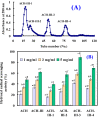Isolation and characterization of collagen and antioxidant collagen peptides from scales of croceine croaker (Pseudosciaena crocea)
- PMID: 24284428
- PMCID: PMC3853751
- DOI: 10.3390/md11114641
Isolation and characterization of collagen and antioxidant collagen peptides from scales of croceine croaker (Pseudosciaena crocea)
Abstract
Acid soluble collagen (ASC) from scales of croceine croaker (ASC-C) was successfully isolated with the yield of 0.37% ± 0.08% (dry weight basis), and characterized as type I collagen on the basis of amino acid analysis and electrophoretic pattern. The antioxidant hydrolysate of ASC-C (ACH) was prepared through a two-stage in vitro digestion (4-h trypsin followed by 4-h pepsin), and three antioxidant peptides (ACH-P1, ACH-P2, and ACH-P3) were further isolated from ACH using ultrafiltration, gel chromatography, and RP-HPLC, and their amino acid sequences were identified as GFRGTIGLVG (ACH-P1), GPAGPAG (ACH-P2), and GFPSG (ACH-P3). ACH-P1, ACH-P2, and ACH-P3 showed good scavenging activities on hydroxyl radical (IC50 0.293, 0.240, and 0.107 mg/mL, respectively), DPPH radical (IC₅₀ 1.271, 0.675, and 0.283 mg/mL, respectively), superoxide radical (IC₅₀ 0.463, 0.099, and 0.151 mg/mL, respectively), and ABTS radical (IC₅₀ 0.421, 0.309, and 0.210 mg/mL, respectively). ACH-P3 was also effectively against lipid peroxidation in the model system. The antioxidant activities of three collagen peptides were due to the presence of hydrophobic amino acid residues within the peptide sequences. The collagen peptides might be used as antioxidant for the therapy of diseases associated with oxidative stress, or reducing oxidative changes during storage.
Figures






Similar articles
-
Anti-Fatigue Effect by Peptide Fraction from Protein Hydrolysate of Croceine Croaker (Pseudosciaena crocea) Swim Bladder through Inhibiting the Oxidative Reactions including DNA Damage.Mar Drugs. 2016 Dec 13;14(12):221. doi: 10.3390/md14120221. Mar Drugs. 2016. PMID: 27983570 Free PMC article.
-
Purification and characterization of three antioxidant peptides from protein hydrolyzate of croceine croaker (Pseudosciaena crocea) muscle.Food Chem. 2015 Feb 1;168:662-7. doi: 10.1016/j.foodchem.2014.07.117. Epub 2014 Aug 5. Food Chem. 2015. PMID: 25172761
-
Antioxidant Peptides from Collagen Hydrolysate of Redlip Croaker (Pseudosciaena polyactis) Scales: Preparation, Characterization, and Cytoprotective Effects on H2O2-Damaged HepG2 Cells.Mar Drugs. 2020 Mar 11;18(3):156. doi: 10.3390/md18030156. Mar Drugs. 2020. PMID: 32168851 Free PMC article.
-
Purification and Characterization of Antioxidant Peptides of Pseudosciaena crocea Protein Hydrolysates.Molecules. 2016 Dec 30;22(1):57. doi: 10.3390/molecules22010057. Molecules. 2016. PMID: 28042837 Free PMC article.
-
Advanced review on type II collagen and peptide: preparation, functional activities and food industry application.Crit Rev Food Sci Nutr. 2024;64(30):11302-11319. doi: 10.1080/10408398.2023.2236699. Epub 2023 Jul 17. Crit Rev Food Sci Nutr. 2024. PMID: 37459185 Review.
Cited by
-
Novel angiotensin-converting enzyme inhibitory peptides from tuna byproducts-milts: Preparation, characterization, molecular docking study, and antioxidant function on H2O2-damaged human umbilical vein endothelial cells.Front Nutr. 2022 Jul 22;9:957778. doi: 10.3389/fnut.2022.957778. eCollection 2022. Front Nutr. 2022. PMID: 35938100 Free PMC article.
-
Extraction and Identification of Three New Urechis unicinctus Visceral Peptides and Their Antioxidant Activity.Mar Drugs. 2022 Apr 27;20(5):293. doi: 10.3390/md20050293. Mar Drugs. 2022. PMID: 35621944 Free PMC article.
-
Physicochemical Properties and Biocompatibility Evaluation of Collagen from the Skin of Giant Croaker (Nibea japonica).Mar Drugs. 2018 Jun 29;16(7):222. doi: 10.3390/md16070222. Mar Drugs. 2018. PMID: 29966234 Free PMC article.
-
Progress in Preparation Technology and Functional Research On Marine Bioactive Peptides.Mar Biotechnol (NY). 2025 Feb 5;27(1):42. doi: 10.1007/s10126-024-10401-0. Mar Biotechnol (NY). 2025. PMID: 39907808 Review.
-
Bioactive and functional properties of protein hydrolysates from fish frame processing waste using plant proteases.Environ Sci Pollut Res Int. 2016 Dec;23(24):24901-24911. doi: 10.1007/s11356-016-7618-9. Epub 2016 Sep 24. Environ Sci Pollut Res Int. 2016. PMID: 27662858
References
-
- Sampath Kumar N.S., Nazeer R.A., Jaiganesh R. Purification and identification of antioxidant peptides from the skin protein hydrolysate of two marine fishes, horse mackerel (Magalaspis cordyla) and croaker (Otolithes ruber) Amino Acids. 2012;42:1641–1649. doi: 10.1007/s00726-011-0858-6. - DOI - PubMed
-
- Lee W.S., Jeon J.K., Byun H.G. Characterization of a novel antioxidative peptide from the sand eel Hypoptychus dybowskii. Proc. Biochem. 2011;46:1207–1211. doi: 10.1016/j.procbio.2011.02.001. - DOI
Publication types
MeSH terms
Substances
LinkOut - more resources
Full Text Sources
Other Literature Sources
Medical
Miscellaneous

